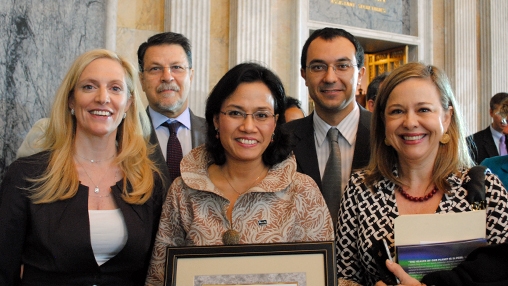Statistics show that protected areas discourage deforestation by providing clear policy guidance and environmental enforcement, supporting indigenous peoples, redirecting territorial occupation and making conservation-based business more attractive.
Covering an area 50% larger than all U.S. National Parks combined at a fraction of the cost,ARPA alone can be credited with a 37% decrease in deforestation between 2004-2009, notes a study by the US National Academy of Sciences.
The Amazon wields significant influence on regional and world climates and so protecting it is of vital importance,not only for Brazil, but also to support biodiversity on a global scale .
“Preserving standing tropical forests allows governments, corporations and financial institutions to take immediate action in reducing greenhouse emissions while preserving areas of high biodiversity importance,” explained World Bank Managing Director, Sri Mulyani Indrawati, on receiving the award.
Global experience
“Through ARPA we have been able to assist Brazil in its efforts to reduce deforestation and, at the same time, gain valuable experience that can be shared globally,” she added.
Comprising of two phases and financed by US$46 million in grants from the GEF, the World Bank-implemented ARPA launched in 2002 in Johannesburg, South Africa.
This long-term initiative is supported by the Brazilian government, the World Bank, GEF, the World Wildlife Fund and the German Development Bank. Upon completion, ARPA will cover nearly 70 million hectares of rainforest, saving more than 1.1 billion tons of CO2 emissions through 2050.
Collectively, these forests make up an area larger than Texas or the Ukraine, store more than 4.6 billion tons of carbon, or about 18% of the Amazon's total carbon stock, and are home to countless plant and animal species.
But beyond the numbers, ARPA is more than just a program to create protected areas. “It has changed the face of land use and helped putting a value on its resources, thus having a true impact on regional development,” notes Brazilian biologist and World Bank expert Adriana Moreira.
More partnerships, less deforestation
Moreira explains that protected areas fall into two categories -”strict protection” and “sustainable use”-, which better balance conservation goals and the use of natural resources.
The former consists of National, state and municipal parks, as well as biological reserves and ecological stations. Sustainable use areas include extractive and sustainable development reserves.
ARPA requires that all protected areas should have ‘protection plans’ before a final management plan is set up. This has ramped up support for environmental enforcement, as well as strengthening partnerships with environmental law agencies and empowering protected areas managers and staff.
ARPA’s first success story is the Montanhas do Tumucumaque National Park, in Amapa province, and at 3.8 million hectares, it is the same size as Belgium. “But creating Tumucumaque was relatively easy because it is an isolated area.
Consolidating an ecological station in an area such as Terra do Meio (between Para and Mato Grosso states), which is an agricultural and a deforestation frontier, was a lot more challenging,” noted Moreira.
While acknowledging that deforestation still takes place within protected areas, experts agree that it is a lot less aggressive than elsewhere, with deforestation 7 to 11 times less likely within protected areas than outside them.

